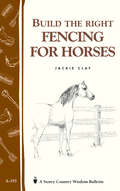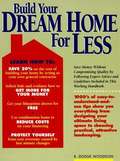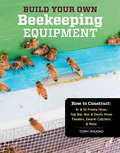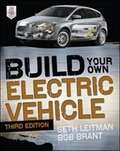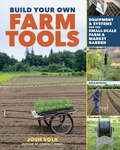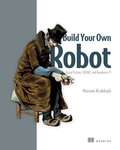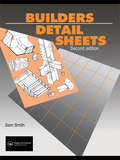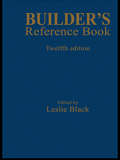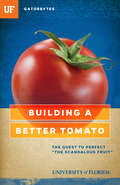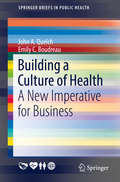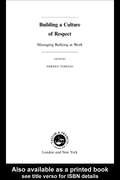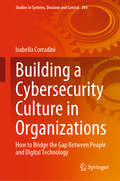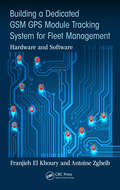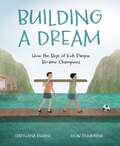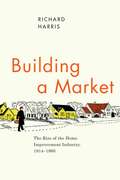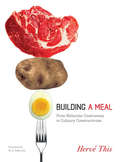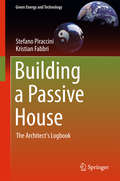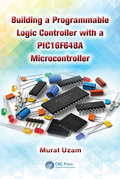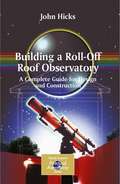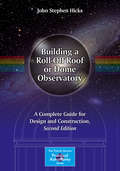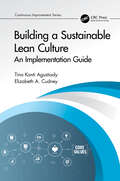- Table View
- List View
Build the Right Fencing for Horses: Storey's Country Wisdom Bulletin A-193 (Country Wisdom Bulletin Ser. #Vol. 193)
by Jackie ClaySince 1973, Storey's Country Wisdom Bulletins have offered practical, hands-on instructions designed to help readers master dozens of country living skills quickly and easily. There are now more than 170 titles in this series, and their remarkable popularity reflects the common desire of country and city dwellers alike to cultivate personal independence in everyday life.
Build Your Dream Home for Less
by R. Dodge WoodsonReaders learn how to be their own general contractors and save money on every aspect of home-building, without compromising quality. Walk, with Woodson, step-by-step through the building process from site selection to finish trim. Includes an appendix of sample forms and contracts.
Build Your Own Beekeeping Equipment: How to Construct 8- & 10-Frame Hives; Top Bar, Nuc & Demo Hives; Feeders, Swarm Catchers & More
by Tony PisanoSave time and money by building your own beekeeping equipment. Learn to craft equipment that is tailored to your particular climate and setup. Full of insightful tips and covering a variety of hive types, Pisano includes all the basic infrastructure you need to keep your bees happy and active — and your pantry full of honey.
Build Your Own Electric Vehicle (Build Your Own)
by Seth Leitman Bob BrantBUILD, CONVERT, OR BUY A STATE-OF-THE-ART ELECTRIC VEHICLE: Thoroughly revised and expanded, Build Your Own Electric Vehicle, Third Edition, is your go-to guide for converting an internal combustion engine vehicle to electric or building an EV from the ground up. You'll also find out about the wide variety of EVs available for purchase and how they're being built. This new edition details all the latest breakthroughs, including AC propulsion and regenerative braking systems, intelligent controllers, batteries, and charging technologies. <p><p> Filled with updated photos, this cutting-edge resource fully describes each component--motor, battery, controller, charger, and chassis--and provides illustrated, step-by-step instructions on how to assemble all the parts. Exclusive web content features current supplier and dealer lists. Custom-built for environmentalists, engineers, students, hobbyists, and mechanics, this hands-on guide puts you in the fast lane toward a cost-effective, reliable green machine. <p><p> This Third Edition, covers: Environmental impact and energy savings, The best EV for you--purchase trade-offs, conversion trade-offs, and conversion costs, Chassis and design, Different types of electric motors and controllers, Lithium EV batteries, Chargers and electrical systems, EV builds and conversions, Licensing and insuring your EV, Driving and maintenance, List of manufacturers and dealers regularly updated on website.
Build Your Own Farm Tools: Equipment & Systems for the Small-Scale Farm & Market Garden
by Josh VolkJosh Volk, author of the best-selling Compact Farms, offers small-scale farmers an in-depth guide to building customized equipment that will save time and money and introduce much-needed efficiencies to their operations. Volk begins with the basics, such as setting up a workshop and understanding design principles, mechanical principles, and materials properties, then presents plans for making 15 tools suited to small-farm tasks and processes. Each project includes an explanation of the tool&’s purpose and use, as well as the time commitment, skill level, and equipment required to build it. Projects range from the super-simple (requiring a half-day to build) to the more complex, and include how-to photographs and illustrations with variations for customizing the finished implement. Along with instructions for building items such as simple seedling benches, a mini barrel washer, a DIY germination chamber, and a rolling pack table, Volk addresses systems design for farm efficiency, including how to design an effective drip irrigation system and how to set up spreadsheets for collecting important planning, planting, and market data. This publication conforms to the EPUB Accessibility specification at WCAG 2.0 Level AA.
Build Your Own Robot: Using Python, CRICKIT, and Raspberry PI
by Marwan AlsabbaghA DIY guide to bringing your first robot to life with cheap and basic components.Build Your Own Robot introduces you to the exciting world of robotics in a way that&’s fun and affordable! You&’ll build your own real robot with easy-to-find hardware and free open source software. Plus, all the components you need can be assembled with simple tools like a screwdriver. In Build Your Own Robot you&’ll learn how to: Use cameras to capture photos and let your robot see Add cameras and basic computer vision Coordinate DC motors to move your robot Write a web app to control your robot Set up controls for joysticks Read QR codes to find and identify objects This book shows you how anyone can start building their own robot—no special soldering or electronic skills required. All you need is some basic Python know-how to get started. From scratch, you&’ll go hands-on with DC motors, touch sensors, custom shell scripting, joystick controls, and even face detection for your robot friend. About the technology You can build your own robot! With this book, you&’ll use readily-available hardware and author Marwan Alsabbagh&’s clear step-by-step instructions to create a robot that moves, manipulates objects, and responds to its environment. Along the way, you&’ll learn some serious skills like computer vision, networking, and the basics of robotics programming. About the book Build Your Own Robot is a project-based guide that takes you from spinning your first DC motor to programming a mobile robot that you can control from your phone or computer. You&’ll write simple Python code to help your new friend spin, move, and find its way. You&’ll even teach it to track faces and fetch snacks. Plus, a helpful hardware purchasing guide makes it easy to find exactly what you need to get started! What's inside Coordinate DC motors to move your robot Write a web app to control your robot Adding cameras and basic computer vision Read QR codes to find and identify objects About the reader Examples use simple Python code. No special skills or expensive tools required. About the author Marwan Alsabbagh is a seasoned software developer, who has studied mathematics and computer science at McGill University. The technical editor on this book was Alexander Ryker. Table of Contents 1 What is a robot? 2 Getting started 3 Driving the robot 4 Creating a robot shell 5 Controlling robots remotely 6 Creating robot web apps 7 Joystick-controlled robots 8 Keyboard-controlled camera 9 Face-following camera 10 Robotic QR code finder 11 Building a snack-pushing robot A Hardware purchasing guide B Configuring the Raspberry Pi C Robot assembly guide D Mocking the CRICKIT library
Builders' Detail Sheets (Series 1)
by S. Smith Mr P Stronach P. StronachThis book contains a unique set of information sheets, covering all aspects of building from sit setting-out to roofs and floors. It gives builders and students of building a sound knowledge of materials, their properties and limitations, and shows the practice of using these materials for sound construction. The sheets also give information on the Building Regulations and how to comply with them.
Builder's Reference Book
by Leslie BlackA comphensive guide to information sources relevant to the building industry and legislation affecting it. It is designed for use as a tool either in the office or on site, giving facts in a compendium style to meet the most common requirements of the busy builder.
Building: 3,000 Years of Design, Engineering and Construction
by Bill AddisCambridge International AS and A Level Business Studies Revision Guide has been designed to help students prepare for Cambridge International AS and A Level Business Studies (9707) examinations. Written in an easy-to-follow style, the book helps in reinforcing students' understanding and provides guidance on revision.
Building a Better Tomato: The Quest to Perfect "The Scandalous Fruit"
by Jeff Klinkenberg University of FloridaIn the search for a superior alternative to bland and mealy grocery-store tomatoes, horticultural scientist Harry Klee and renowned taste researcher Linda Bartoshuk teamed up and are hot on the trail of a specimen that will have you thinking you just picked it in your own back yard. Gatorbytes highlight for the intellectually curious the world of innovative research happening at the University of Florida. Written by professional journalists, Gatorbytes feature the top research and preeminence work being conducted at the University of Florida, written in a way that’s easy to understand.
Building a Better World: From Toys to Tools (Fountas & Pinnell Classroom, Guided Reading Grade 5)
by Nicole WalkerOutside the Box It's safe to say that people everywhere enjoy building things using LEGO kits, blocks, or a combination of many toys. Then there are those who think outside the box. They are people who have used toys to improve the lives of others. NIMAC-sourced textbook
Building a Culture of Health: A New Imperative for Business (SpringerBriefs in Public Health)
by John A. Quelch Emily C. BoudreauThis ambitious volume sets out to understand how every company impacts public health and introduces a robust model, rooted in organizational and scientific knowledge, for companies committed to making positive contributions to health and wellness. Focusing on four interconnected areas of corporate impact, it not only discusses the business imperative of promoting a healthier society and improved living conditions worldwide, but also provides guidelines for measuring a company's population health footprint. Examples, statistics and visuals showcase emerging corporate involvement in public health and underscore the business opportunities available to companies that invest in health. The authors offer a detailed roadmap for optimizing health-promoting actions in a rapidly evolving business and social climate across these core areas: Planning and building a culture of health Consumer health: How organizations affect the safety, integrity, and healthfulness of the products and services they offer to their customers and end consumers Employee health: How organizations affect the health of their employees (e. g. , provision of employer-sponsored health insurance, workplace practices and wellness programs) Community health: How organizations affect the health of the communities in which they operate and do business Environmental Health: How organizations' environmental policies (or lack thereof) affect individual and population health Implementing and sustaining a culture of health Building a Culture of Health clarifies both a mission and a vision for use by MPH and MBA students in health management, professors in schools of public health and business schools, and business leaders and chief medical officers in health care and non-health care businesses.
Building a Culture of Respect: Managing Bullying at Work
by Noreen TehraniBullying is an increasing problem in the workplace. It is estimated that five million workers are bullied each year in the UK, and that one in four employees is aware of colleagues being bullied. Bullying creates significant health problems for employees and, despite this, there is a conspicuous absence of published material on why these behaviors
Building a Cybersecurity Culture in Organizations: How to Bridge the Gap Between People and Digital Technology (Studies in Systems, Decision and Control #284)
by Isabella CorradiniThis book offers a practice-oriented guide to developing an effective cybersecurity culture in organizations. It provides a psychosocial perspective on common cyberthreats affecting organizations, and presents practical solutions for leveraging employees’ attitudes and behaviours in order to improve security.Cybersecurity, as well as the solutions used to achieve it, has largely been associated with technologies. In contrast, this book argues that cybersecurity begins with improving the connections between people and digital technologies. By presenting a comprehensive analysis of the current cybersecurity landscape, the author discusses, based on literature and her personal experience, human weaknesses in relation to security and the advantages of pursuing a holistic approach to cybersecurity, and suggests how to develop cybersecurity culture in practice. Organizations can improve their cyber resilience by adequately training their staff. Accordingly, the book also describes a set of training methods and tools. Further, ongoing education programmes and effective communication within organizations are considered, showing that they can become key drivers for successful cybersecurity awareness initiatives. When properly trained and actively involved, human beings can become the true first line of defence for every organization.
Building a Dedicated GSM GPS Module Tracking System for Fleet Management: Hardware and Software
by Franjieh El Khoury Antoine ZgheibThis book shows how to build a "INFelecPHY GPS Unit" (IEP-GPS) tracking system for fleet management that is based on 3G and GPRS modules. This model should provide reliability since it deals with several protocols: 1) HTTP and HTTPS to navigate, download and upload in real time the information to a web server, 2) FTTP and FTTPS to handle in a non-real time the files to the web application, and 3) SMTP and POP3 to send and receive email directly from the unit in case of any alert. Similar to a mobile device, but without screen for display, it is multifunctional because it links to a GPRS module, a camera, a speaker, headphone, a keypad and screen.
Building a Dream: How the Boys of Koh Panyee Became Champions
by Darshana KhianiAn unforgettable tale of persistence and problem-solving, based on the amazing true story of a Thai soccer team who made their own place to play.In Thailand&’s Phang Nga Bay, atop a network of stilts, floats the village of Koh Panyee—where a group of boys loved soccer but had nowhere to practice. Where could they find space to dribble, juggle, shoot, and score? The boys looked out at the water and started gathering tools. Even while their neighbors laughed, they sawed wood, hammered nails, and tied barrels together. The team worked for weeks to build Koh Panyee&’s first floating field—a place to practice, and a place to transform their community... With engaging soccer scenes and atmospheric images of southern Thailand, this inspiring book follows a group of boys who became a team long before they had jerseys or even a field. Plank by plank, they built their dream.
Building a Low-Carbon Future: Adaptive Control Strategies for Distributed Energy Networks (Studies in Systems, Decision and Control #506)
by Jiayue Sun Meina Zhai Shu Liu Peng ShiThis book aims to emphasize the state-of-the-art research in realizing the optimal synthesis of microgrid voltage regulation problems using adaptive multi-agent control theory. The contents of this book are divided into four parts. The book describes the microgrid voltage regulation model construction. Building upon this foundation, the book investigates fault-tolerant and event-triggered control problems under different constraints. The effectiveness and applicability of the design methods are verified by simulation arithmetic and applications.The key features of this book are summarized as follows.1) Development of a unified modeling framework for the analysis and design of voltage regulation protocols. 2) Utilization of a novel approach to analyze microgrid secondary control systems, addressing various issues such as event triggering and fault-tolerant control problems. 3) A set of newly developed techniques (e.g., Lyapunov stability theory, LMI techniques) is used to addressemerging voltage regulation challenges.This book is a timely reflection of developments in the new field of integrated theory of voltage regulation and multi-agent system control for microgrids. It serves as a comprehensive collection of the latest research findings, making it a valuable textbook for senior and graduate students who are interested in acquiring knowledge about the following: 1) the latest techniques in microgrid voltage regulation; 2) the latest advances in multi-agent system control; and 3) the latest advances in stability/performance analysis, tracking control, fault-tolerant control, event-triggeredcontrol, and adaptive control. The content of this monograph is divided into six parts. 1) Part one studies the classical problems of microgrid control and multi-agent control. 2) Part two focuses on the event-triggered fault-tolerant voltage restoration problem for islanded microgrids. 3) Part three addresses the fully distributed fault-tolerant secondary event-triggered control of microgrids under directed graphs. 4) Part four examines the output feedback-based fault-tolerant load voltage regulation problem using intermittent communication. 5) Part five presents the secondary load voltage and frequency regulation control based on hierarchical fault-tolerant containment control. 5) Part six investigates the distributed critical bus voltage regulation control problem for multiple microgrids with a positive minimum inter-event time.
Building a Market: The Rise of the Home Improvement Industry, 1914-1960
by Richard HarrisEach year, North Americans spend as much money fixing up their homes as they do buying new ones. This obsession with improving our dwellings has given rise to a multibillion-dollar industry that includes countless books, consumer magazines, a cable television network, and thousands of home improvement stores. Building a Market charts the rise of the home improvement industry in the United States and Canada from the end of World War I into the late 1950s. Drawing on the insights of business, social, and urban historians, and making use of a wide range of documentary sources, Richard Harris shows how the middle-class preference for home ownership first emerged in the 1920s--and how manufacturers, retailers, and the federal government combined to establish the massive home improvement market and a pervasive culture of Do-It-Yourself. Deeply insightful, Building a Market is the carefully crafted history of the emergence and evolution of a home improvement revolution that changed not just American culture but the American landscape as well.
Building a Meal: From Molecular Gastronomy to Culinary Constructivism
by Hervé ThisAn internationally renowned chemist, popular television personality, and bestselling author, Hervé This heads the first laboratory devoted to molecular gastronomy-the scientific exploration of cooking and eating. By testing recipes that have guided cooks for centuries, and the various dictums and maxims on which they depend, Hervé This unites the head with the hand in order to defend and transform culinary practice.With this new book, Hervé This's scientific project enters an exciting new phase. Considering the preparation of six bistro favorites-hard-boiled egg with mayonnaise, simple consommé, leg of lamb with green beans, steak with French fries, lemon meringue pie, and chocolate mousse-he isolates the exact chemical properties that tickle our senses and stimulate our appetites. More important, he connects the mind and the stomach, identifying methods of culinary construction that appeal to our memories, intelligence, and creativity. By showing that the creation of a meal is as satisfying as its consumption, Herve This recalibrates the balance between food and our imaginations. The result is a revolutionary perspective that will tempt even the most casual cooks to greater flights of experimentation.
Building a National Framework for the Establishment of Regulatory Science for Drug Development: Workshop Summary
by Institute of Medicine of the National AcademiesThe Food and Drug Administration (FDA) is tasked with ensuring the safety and effectiveness of medicine. FDA's science base must be strong enough to make certain that regulatory decisions are based on the best scientific evidence. The IOM held a public workshop on February 26, 2010, to examine the state of regulatory science and to consider approaches for enhancing it.
Building a Passive House: The Architect's Logbook (Green Energy and Technology)
by Kristian Fabbri Stefano PiracciniThis book describes step-by-step the entire building process of a passive, energy-efficient house in a Mediterranean climate. It chronicles the creation of the Fiorita Passive House in Cesena, Italy, offering designers valuable tips and practical advice for their own projects. Written as a logbook, it not only provides essential technical information but is also an exciting story of the challenges encountered and the solutions that were found. "How and where do I start when building a passive house? Do I need consultants? Will it cost too much? What precautions should I take in a Mediterranean region? What tools do I need? I want to build in wood, but what technical solutions should I use? What must I do regarding plants and equipment? And then, finally, will it really work?" These and many other questions filled the head of the author and designer when he tried his hand at building a passive house in the Mediterranean. The designer, S. Piraccini, had long sought a book that would answer these answers - in vain. So he decided to brave these dangerous waters alone, and after successfully completing his project, he decided to write a book to help others in the same situation. The book is accompanied by detailed information on building physics and HVAC systems by his fellow architect, K. Fabbri.
Building a Programmable Logic Controller with a PIC16F648A Microcontroller
by Murat UzamProgrammable logic controllers (PLCs) are extensively used in industry to perform automation tasks, with manufacturers offering a variety of PLCs that differ in functions, program memories, and the number of inputs/outputs (I/O). Not surprisingly, the design and implementation of these PLCs have long been a secret of manufacturers. Unveiling the mysteries of PLC technology, Building a Programmable Logic Controller with PIC16F648A Microcontroller explains how to design and use a PIC16F648A-microcontroller-based PLC. The author first described a microcontroller-based implementation of a PLC in a series of articles published in Electronics World magazine between 2008 and 2010. This book is based on an improved version of the project, including:Updates to the hardware configuration, with a smaller CPU board and two I/O extension boards that now support 16 inputs and 16 outputs instead of 8An increased clock frequency of 20 MHzImprovements to several macrosFlowcharts to help you understand the macros (functions)In this book, the author provides detailed explanations of hardware and software structures. He also describes PIC Assembly macros for all basic PLC functions, which are illustrated with numerous examples and flowcharts. An accompanying CD contains source files (.ASM) and object files (.HEX) for all of the examples in the book. It also supplies printed circuit board (PCB) (Gerber and .pdf) files so that you can have the CPU board and I/O extension boards produced by a PCB manufacturer or produce your own boards.Making PLCs more easily accessible, this unique book is written for advanced students, practicing engineers, and hobbyists who want to learn how to build their own microcontroller-based PLC. It assumes some previous knowledge of digital logic design, microcontrollers, and PLCs, as well as familiarity with the PIC16F series of microcontrollers and w
Building a Roll-Off Roof Observatory: A Complete Guide for Design and Construction (The Patrick Moore Practical Astronomy Series)
by John Stephen HicksAlmost every amateur astronomer who has taken the pursuit to its second level aspires to a fixed, permanent housing for his telescope, permitting its rapid and comfortable use avoiding hours of setting-up time for each observing session. A roll-off roof observatory is the simplest and by far the most popular observatory design for today's practical astronomers. Building a Roll-off Roof Observatory is unique, covering all aspects of designing a roll-off roof observatory: planning the site, viewing requirements, conforming to by-laws, and orientation of the structure. The chapters outline step-by-step construction of a typical building. The author, both an amateur astronomer and professional landscape architect, is uniquely qualified to write this fully-detailed book. A professionally designed roll-off observatory could cost as much as $3000 just for the plans - which are provided free with Building a Roll-off Roof Observatory.
Building a Roll-Off Roof or Dome Observatory: A Complete Guide for Design and Construction (The Patrick Moore Practical Astronomy Series)
by John Stephen HicksAlmost every practical astronomer eventually aspires to have a fixed, permanent observatory for his or her telescope. A roll-off roof or dome observatory is the answer for the most popular home observatory design. Building a Roll-Off or Dome Observatory will help you decide whether to embark on the venture and will certainly increase your enthusiasm for the project. The author, both an amateur astronomer and a professional landscape architect, answers many of the common questions asked about observatory construction, covering the following topics: * Zoning, and by-law requirements common to most states, towns and municipalities * Where to locate the observatory * How to tailor the observatory for your particular needs * Tools and structural components required * Possible variations in design * How to combine the structure with other structures (incorporating a garden patio under the gantry in the roll-off roof observatory, for example) This fully detailed outlines step-by-step construction, with professional detailed diagrams for each phase of construction.
Building a Sustainable Lean Culture: An Implementation Guide
by Tina Agustiady Elizabeth A. CudneyThis book is an implementation guide for creating a Lean Culture from the ground up while gaining buy-in from key stakeholders and being able to sustain the results. Everyone talks about implementing a Lean Culture, but only provides Lean Tools for the implementation. This book discusses implementing the entire system from three main aspects. It will cover the people (structural and cultural), the operation system, and the tools. Also included is a full set of case studies to show real-life implementations as well. This text- Discusses Leader Standard work for all employees Covers the escalation process for tiers and daily accountability Shows how to deal with a change of SOP's and standardization within an organization Presents exercises for Lean Tools Implementation Offers real-life case studies of implementing a lean culture while sustaining it Building a Sustainable Lean Culture: An Implementation Guide discusses Lean Leadership from a managerial standpoint and ensures the lean journey does not fail through accountability, standardized work, and technological advances utilizing Lean Systems. Useful in manufacturing, services, IT, and healthcare, this book includes the implementation of empowering employees to want to build a Lean Culture.
